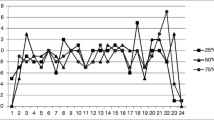Abstract
The successful implementation of open access scheduling requires the match of daily healthcare provider capacity and patient demand at the high level of total capacity and the low levels of individual capacities for different types of appointments. In this paper, we introduce 12 scheduling rules for determining the two-level provider capacities and compare them in terms of four performance metrics: the probabilities of granting requests for fixed and open appointments, and the expectation and the variance of the number of patients consulted. Our analytical results show that adjusting low level provider capacities can reduce the difference between the two probabilities. When the ratios of low level capacities to the high level provider capacity are fixed, the two probabilities increase with the increase in the high level capacity. Meanwhile, our numerical results demonstrate that the expectation and the variance of the number of patients consulted increase with the increase in the high level capacity. The results provide insights in determining optimal two-level provider capacities to match daily patient demand. Potential approaches to optimality are also proposed based on the results.


Similar content being viewed by others
References
Organisation for Economic Cooperation and Development (2007) OECD Health Data 2007 (available at http://www.oecd.org/dataoecd/46/36/38979632.xls)
Lacy NL, Paulman A, Reuter MD, Lovejoy B (2004) Why we don’t come: patient perceptions on no-shows. Ann Fam Med 2(6):541–545
Lee VJ, Earnest A, Chen MI, Krishnan C (2005) Predictors of failed attendances in a multi-specialty outpatient centre using electronic databases. BMC Health Serv Res 5:51–58
Pinto MB, Parente DH, Barber JC (2002) Selling open access health care delivery to patients and administrators: what’s the hook? Health Market Q 19(3):57–69
Murray M, Berwick DM (2003) Advanced access: reducing waiting and delays in primary care. JAMA 289(8):1035–1040
Herriott S (1999) Reducing delays and waiting times with open-office scheduling. Fam Pract Manag 6(4):38–43
Murray M, Tantau C (2000) Same-day appointments: exploding the access paradigm. Fam Pract Manag 7(8):45–50
Kennedy JG, Hsu JT (2003) Implementation of an open access scheduling system in a residency training program. Fam Med 35(9):666–670
Kodjababian JG (2003) Improving patient access and continuity of care: a successful implementation of open access scheduling (Egg Management Consultants, Inc. available at http://www.ecgmc.com/insights_ideas/pdfs/Open_Access_Scheduling_Implementation.pdf)
O’Hare CD, Corlett J (2004) The outcomes of open-access scheduling. Fam Pract Manag 11(2):35–38
Bundy DG, Randolph GD, Murray M, Anderson J, Margolis PA (2005) Open access in primary care: results of a North Carolina pilot project. Pediatrics 116(1):82–87
Mallard SD, Leakeas T, Duncan WJ, Fleenor ME, Sinsky RJ (2004) Same-day scheduling in a public health clinic: a pilot study. J Public Health Manag Pract 10(2):148–155
Pickin M, O’Cathain A, Sampson FC, Dixon S (2004) Evaluation of advanced access in the national primary care collaborative. Br J Gen Pract 54(502):334–340
Parente DH, Pinto MB, Barber JC (2005) A pre-post comparison of service operational efficiency and patient satisfaction under open access scheduling. Health Care Manage Rev 30(3):220–228
Gosavi A, Bandla N, Das TK (2002) A reinforcement learning approach to a single leg airline revenue management problem with multiple fare classes and overbooking. IIE Trans 34:729–742
Kimes SE (1999) Implementing restaurant revenue management. Cornell Hotel Restaur Adm Q 40:16–21
McGill JI, van Ryzin GJ (1999) Revenue management: research overview and prospects. Transp Sci 33(2):233–256
Green LV, Savin S, Wang B (2006) Managing patient service in a diagnostic medical facility. Oper Res 54(1):11–25
Green LV, Savin S (2005) Designing appointment systems for outpatient healthcare facilities. Proceedings of the 2005 MSOM Conference (Available at http://www.kellogg.northwestern.edu/msom2005/papers/Savin.pdf)
Qu X, Rardin RL, Williams JAS, Willis DR (2007) Matching daily healthcare provider capacity to demand in advanced access scheduling systems. Eur J Oper Res 187:812–826
Qu X (2006) Development of appointment scheduling rules for open access scheduling. Ph.D. dissertation thesis, Purdue University, West Lafayette, IN
Dexter F (1999) Design of appointment systems for preanesthesia evaluation clinics to maximize patient waiting times: a review of computer simulation and patient survey studies. Anesth Analg 89:925–931
Shonick W, Klein BW (1977) An approach to reducing the adverse effects of broken appointment in primary care systems: development of a decision rule based on estimated conditional probabilities. Med Care 15(5):419–429
Blanco White MJ, Pike MC (1964) Appointment systems in outpatients’ clinics and effect of patients’ unpunctuality. Med Care 2:133–145
Vissers J (1979) Selecting a suitable appointment system in an outpatient setting. Med Care 17:1207–1220
DeLaurentis P, Kopach R, Rardin R, Lawley M, Muthuraman K, Wan H, Ozsen L, Intrevado P (2006) Open access appointment scheduling—an experience at a community clinic. In: Proceedings of 2006 IIE annual conference and exposition, Orlando, FL
Qu X, Rardin RL, Williams JAS, Tieman L, Wan H, Willis DR, Rosenman MB. A statistical model for the prediction of patient non-attendance in a primary care clinic. In: Proceedings of 2006 IIE annual conference and exposition, Orlando, FL
Kopach R, DeLaurentis PC, Lawley M, Muthuraman K, Ozsen L, Rardin R, Wan H, Intrevado P, Qu X, Willis D (2007) Effects of clinical characteristics on successful open access scheduling. Health Care Manage Sci 10(2):111–124
Acknowledgement
The authors are grateful to the reviewers for the thoughtful suggestions to improve the quality of this paper. The authors would like to thank the administrators in the Indiana University Medical Group—Primary Care clinics for providing necessary help.
Author information
Authors and Affiliations
Corresponding author
Rights and permissions
About this article
Cite this article
Qu, X., Shi, J. Effect of two-level provider capacities on the performance of open access clinics. Health Care Manag Sci 12, 99–114 (2009). https://doi.org/10.1007/s10729-008-9083-6
Received:
Accepted:
Published:
Issue Date:
DOI: https://doi.org/10.1007/s10729-008-9083-6




